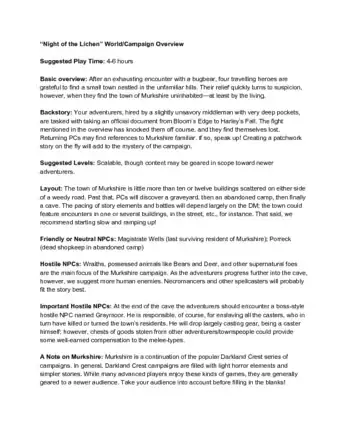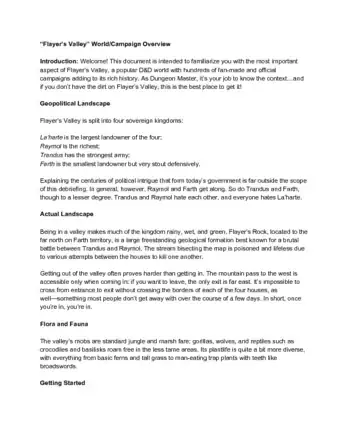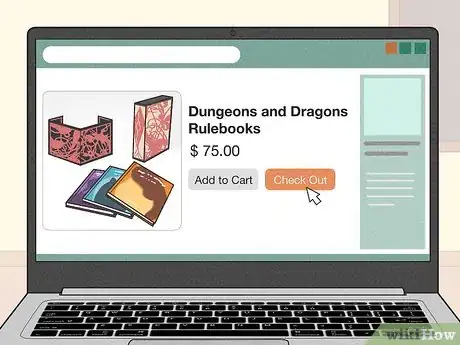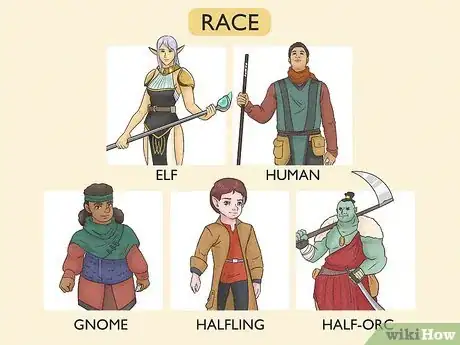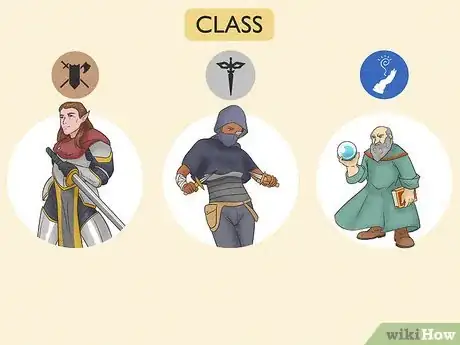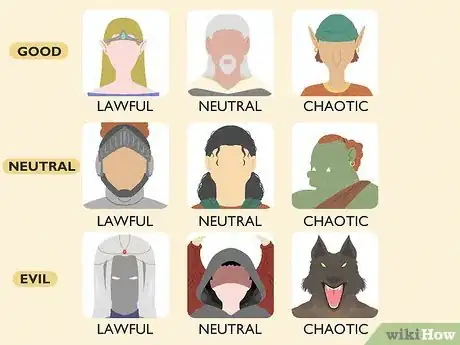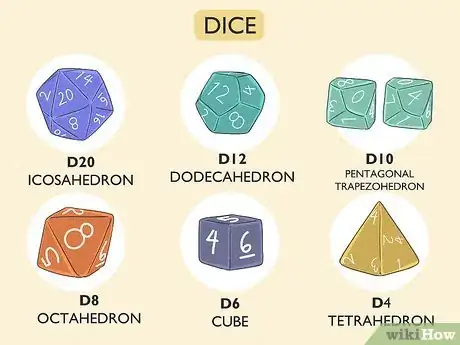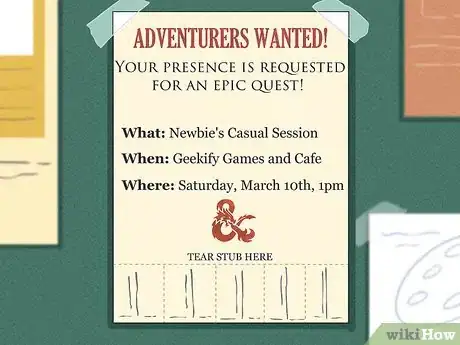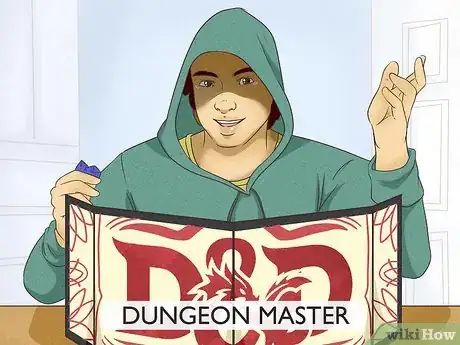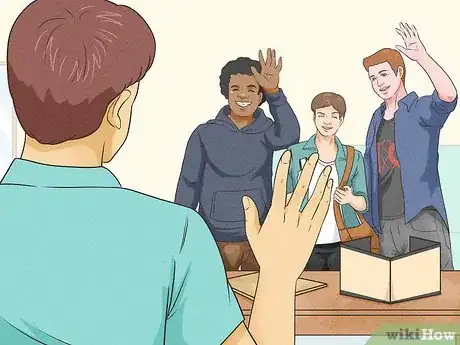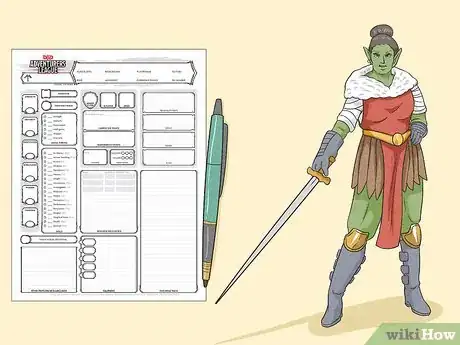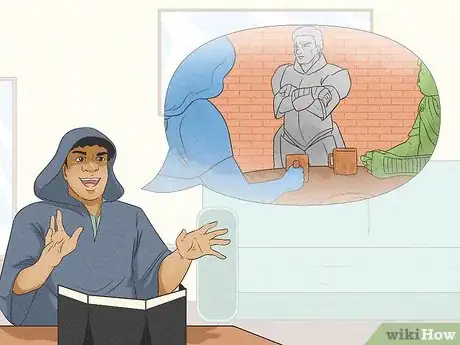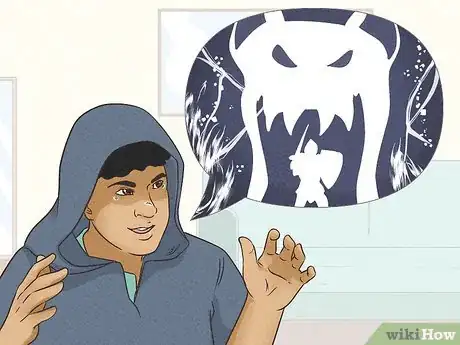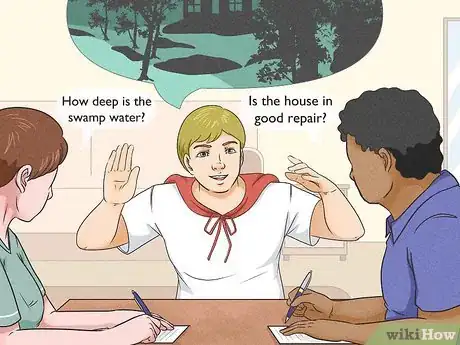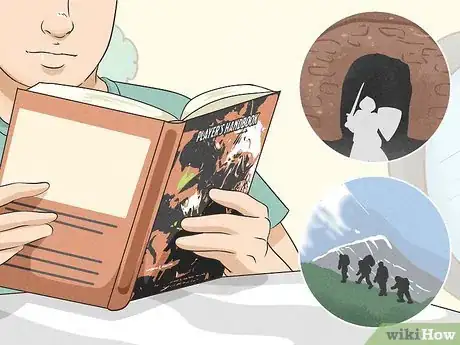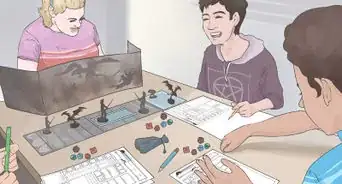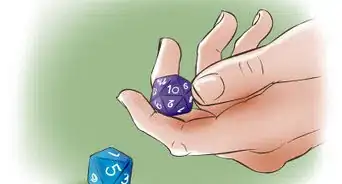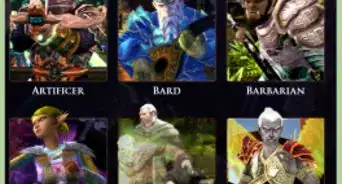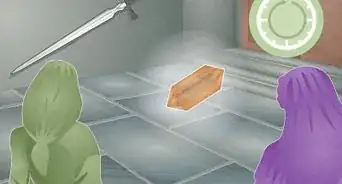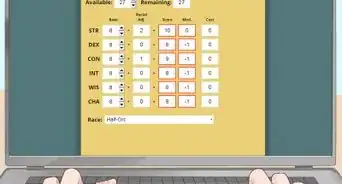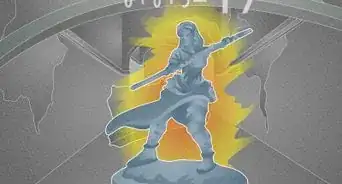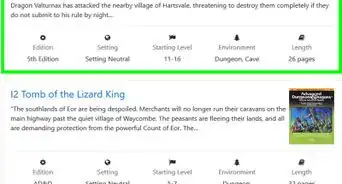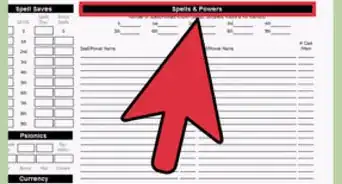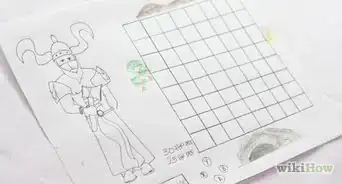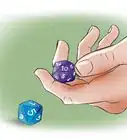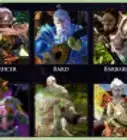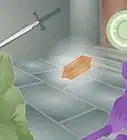wikiHow is a “wiki,” similar to Wikipedia, which means that many of our articles are co-written by multiple authors. To create this article, 75 people, some anonymous, worked to edit and improve it over time.
This article has been viewed 1,393,507 times.
Learn more...
Dungeons & Dragons is a really good game to play while you are bored, or if you want to expand the realms of your imagination. After all, a game with a depth such as this really needs a lot of work to be played right. Here are some things to do to be able to play this magnificent game.
Steps
Sample Campaigns
Getting to Know the Basics
-
1Purchase the handbooks. To be able to play Dungeons & Dragons, also known as D&D or more commonly DnD, you need to know the rules. If you can't find a store to buy the books from, try some website such as amazon.com. Read through the handbooks to the point that you understand the basic rules.
- There are several editions of the game, with different rules and procedures. The 5th edition is considered to be the most user friendly and easiest to pick up. The Fifth Edition is also the most current as of 2021.
-
2Understand race. There are different races which your character can be. These vary slightly between editions, but the most common include human, dwarf, elf, halfling, half-elf, half-orc, and gnome. The different races will have different inherent abilities, benefits and downsides. This will affect how your character gets by in life.Advertisement
-
3Understand class. Class is what your character does, what they’re good at or have chosen to do with their life. Importantly, it determines the skills they will have which affects the role your character will have in the group. It is important to choose a class befitting your race. The classes are, again, different depending on edition. Common classes include fighter, rogue, and wizard.
-
4Understand alignment. Your character will also have a moral alignment which you will need to consider. This will help you determine how your character would react in certain situations, as well as the decisions they would make.
-
5Understand the role of the dice. There are a number of dice used when playing DnD. These are not just normal dice, but rather special dice with an unusual number of sides. The most common DnD dice is the classic d20 (quickly followed by a d10) but you will need a number of others. The best option is to get a full set from your local game shop.
- The dice will be used almost every time the player or Dungeon Master (DM) takes an action. The difficulty or chance of something occurring is attached to a particular type of dice. You roll, and if the number is high enough then the action can occur, going well, terribly, or any number of other outcomes as determined by the DM.
Setting Up a Game
-
1Join a game. The simplest, best, and easiest way to get started is to join an existing group. If you are less socially apt than average, this can seem daunting but ultimately can be a great way for you to make new friends. You can search local forums, ask around at cons, or inquire or advertise at your local game shop. Many universities and colleges, as well as some high schools, will also have clubs.
- You must email, phone and/or meet the person hosting the group, and ask to join the game. The main thing you want to establish is age or social group. D&D is an activity that a mixed-age group can enjoy, but you don't necessarily want to be the only teenager in a room full of 40-year-olds.
-
2Organize your own game. This takes a little more work on your part. You can advertise in many of the same locations described above or recruit friends, family, or coworkers to play with you.
-
3Designate a Dungeon Master (DM). If you are the one organizing the game, this will likely be you. The DM should have a strong knowledge of the rules, or at least be willing to learn and run the game. They will want to do a little bit of preparation of an adventure before the first session.
- This person should purchase or already have copies of the core rulebooks: The Player's Handbook, the Dungeon Master's Guide, and the Monster Manual (I). There are tons more books available, but you only need these three to run the game.
-
4Find a place to play. Typically this involves a table with some chairs around it, and is usually at the DM's house/apartment (not for any real good reason, that just seems to be how it pans out). This should preferably be somewhere without distractions such as the TV or other folks who won't be playing, though some local pubs or game stores will sometimes specialize in providing facilities to groups for a fee or free.
Playing the Game
-
1Show up. You will, of course, have to actually show up come game night. D&D is a commitment, since it is difficult to enjoy the game if members of the group are constantly missing. When joining a game, you should be willing and prepared to work with their schedule.
-
2Create characters. For the first session, you will need to create your characters. This can be done alone, before meeting as a group, or together. Creating characters together should lead to a more balanced party, as you can discuss what is needed. Doing this together is also helpful for new or inexperienced players.
- Make sure everyone has a blank character sheet, or get everybody to use a program like Redblade for assistance in creating their sheets.
- Read the instructions regarding character creation in the Player's Handbook and have everyone but the DM create a character.
- Take note of the differences between races and classes, and which complement each other. For example, if you decide to be a Fighter and this is your first time out, a Human or Half-Orc will be a far better choice than either an Elf or a Gnome. On the other hand, if you want a challenge, then try a Monk or a Spell Caster of any sort (Sorcerer, Druid, Cleric, Wizard, etc.)
- The character you create will be called your Player Character (PC). All the other characters that are in the game world which are not controlled by a Player are called Non-Player Characters (NPC) and will be controlled by the Dungeon Master.
-
3Begin your adventure. You can move right into this step on the first session after you finish making characters, or this could also be the second session. Either way, this is where you all begin actually playing the game.
- Each player controls their own PCs. You cannot control other people's PC, nor can you control NPCs.
- The DM will describe where you are and what is around you.
- The players all take turns telling the DM what action they would like to do in response. The DM will answer each question and explain what the outcome of any action.
- Play will continue in this way, back and forth between the players and DM.
-
4End of Game - Most sessions will end at or near a predetermined time. The average time is determined by how often you play - if you can play once a week, then those sessions may be only four hours, whereas if you can only play once a month everyone may opt for eight hour sessions. Whichever you prefer, the DM generally keeps track of the time and will call the end of game when appropriate.
- Most DMs prefer to create an episodic "cliff-hanger" feel right before some kind of action to stop at. This essentially pauses the adventure at an intriguing point so that excitement for how it will resolve at the next session is high among the players. Just like a TV show, this will encourage everyone to come back next time!
Example Gameplay
-
1Start the game. Start the game with the DM telling you where you are and some general ideas about your surroundings, Such as: "You find yourself in a swamp. To the North you can see a house. To the West you can go further into the swamp. The East and South passages are blocked by dense growth".
- Player 1: "I move to the North slowly, drawing my sword in case something attacks us."
- Player 2: "How deep is the swamp water?"
- Player 3: "Is the house in good repair?"
- Player 4: "I move to the North, too."
- DM: "The two of you begin to move north slowly, the mud sucking at your boots from below the waterline. The water is about one to two feet deep; generally shin-deep. {Player 3}, you try to determine the quality of the house from where you are. Make a perception check."
- Player 3, who is trying to see if she can do something that may or may not be feasible, is asked to make a "perception check". She will roll a twenty-sided die (d20) and add her skill of perception to the total. The DM, in secret, will determine a number that represents how difficult it would be to succeed; this is called the "DC". If the player's total is equal or above the DC, then the attempt succeeds. More detail on how this works can be found in the Player's Handbook or in the SRD (System Reference Document).
- Player 3 rolls a 13 on the d20. She adds the +3 she has in Spot, giving her PC a total of 16 to see the condition of the house. The DM had made the DC a 10, as it was fairly easy to see.
- DM: "Squinting at the structure, you see that it seems to be leaning a bit to the side, with boards on the windows. It is unlikely that anyone has lived there in some time, but as to anything living there... well, you're not too sure."
-
2Look for other examples. Additional examples of play are located in the Player's Handbook and Dungeon Master Guide.
Community Q&A
-
QuestionI've never played Dungeons and Dragons. Is it worth my money?
 Community AnswerThe books cost a lot. You should buy the starter kit to see if you like role playing games. If it is something you enjoy, then you should buy the books.
Community AnswerThe books cost a lot. You should buy the starter kit to see if you like role playing games. If it is something you enjoy, then you should buy the books. -
QuestionDoes the dungeon master (DM) create the world from scratch?
 Community AnswerYes, the DM may create the world from scratch, but may also use a template found online or in a D&D book.
Community AnswerYes, the DM may create the world from scratch, but may also use a template found online or in a D&D book. -
QuestionHow do I get character sheets?
 Community AnswerThere are numerous websites that have pre-designed character sheets for various classes, or you can make your own.
Community AnswerThere are numerous websites that have pre-designed character sheets for various classes, or you can make your own.
Warnings
- Not everyone will understand the joy of roleplaying. That's their problem, not yours. Have fun no matter what they say.⧼thumbs_response⧽
- It is a good idea to have a game grid system to eliminate any confusion on where everyone is compared to where the monsters are.⧼thumbs_response⧽
- The degree of roleplay is often determined by the group you play with. Learn how far they take the roleplay, and how much comedy is integrated into the roleplay.⧼thumbs_response⧽
- It's good to roleplay, but don't overdo it. For example, you don't need to always say stuff like, "Prithee my liege, but if mine dagger doesn't end up back in my ponce, I'm going to have to splay and butterfly you on a tree. Huzzah!"⧼thumbs_response⧽
- It can be difficult to focus on the adventure when you're with your friends. Gaming sessions frequently lapse into chit-chat. You decide whether this is good or bad.⧼thumbs_response⧽
- If others do not role-play, it is not a problem you should get hung up on. Many do not role-play because they have strong beliefs against witchcraft and may become uncomfortable with someone acting like they can do spells. Others simply feel self-conscious playing "let's pretend" as grown-ups, and would rather focus on the game aspect of D&D. You can still have great fun with playing D&D with people who don't want to role-play!⧼thumbs_response⧽
- Don't throw away the d10 with multiples of ten. This percentile dice is useful when rolling d100 as it is clearly marked and allows players to immediately know which one is the tens digit of the d100 roll.⧼thumbs_response⧽
- Make sure everyone is playing with the same edition. There are major changes from one edition to another, and even 3rd edition to V3.5 has some big changes. If you aren't careful, you may end up creating a character that can't correctly function due to the mix up of rules, or one that appears to be broken (extremely good, usually because of exploits) due to using rules from the wrong edition which has a different balance than the one actually being used.⧼thumbs_response⧽
- Remember not to use knowledge that you have but not your character to influence your character's actions. Doing so is called "metagaming" and is generally unwanted in role-plays, as it can result in strained immersion in the game, and it breaks encounters that are balanced around characters not knowing everything about the encounter. Metagaming can also be considered cheating.⧼thumbs_response⧽
- Do not bring guests with you to a session unannounced. Always ask the DM and the owner of the location you are playing at before you show up with anyone! Spectators typically serve as more of a distraction than anything else and will make many people uncomfortable. This is especially true of the owner of the location. Being courteous and respectful is always important.⧼thumbs_response⧽
Things You'll Need
-
Books for rules and information such as: Dungeons & Dragons: Players Handbook, Dungeons & Dragons: Dungeon Master's Guide, and Dungeons & Dragons: Monster Manual, for the version of Dungeons & Dragons you're playing or running
- All three can be purchased as a starting pack in a slip case for a discount
- The basic rules, called the System Reference Document (SRD), for v3.5 and 5e are online and free (http://www.d20srd.org)
-
Dice: d20, d12, d10 (actually two dice in a pair, one going from 1-10 and another going from 10-100, counting up in tens), d8, 4d6, 2d4
- Extras of the required dice can be used to either give each player their own set of dice, or as spares to be used when multiple dies are called to be rolled at once
- Paper and pen or pencil (for mapping, keeping track of character stats, etc)
- Graph paper (optional): Great for map making for both the DM and the Map Maker
- A friend
References
- The Hypertext d20 SRD Many of the rules for Dungeons & Dragons in easy to use and reference Hypertext form.
- Wikipedia: Dungeons & Dragons More information on D&D from creation to history to character details, etc.
About This Article
Dungeons and Dragons is a fantasy roleplaying game designed for 2-8 players, although playing with 4-5 players is ideal. Unlike most games, Dungeons and Dragons isn’t a game where you’re competing against your friends—the goal is to tell a story and have fun with your friends by acting out characters, defeating enemies in combat, and completing objectives. While Dungeons and Dragons often uses small game-pieces to represent characters in combat, the vast majority of the game relies on the story and character building you do out loud and in your mind. All you need to play are some dice and a copy of the 5th Edition Player’s Handbook, which is the official rulebook for the current version of the game. You also need one player to volunteer as the Dungeon Master, or DM for short. The DM’s job is to script the game (called a campaign), control non-player characters (called NPCs), and answer questions about the in-game world. When playing, it is the DM’s job to narrate action and make rulings on what is and isn’t allowable in the game. For example, a player may ask the DM, “What do I see when I look out the window?” or “Do I know where we are?” and it’s the DM’s job to answer them and describe what’s going on. The DM also prompts players to roll dice to perform certain actions. A player may say, “I want to pickpocket this innkeeper,” and the DM may say, “Ok, roll stealth to see if you’re successful,” or “You go to reach into their pocket and the innkeeper jumps back in confusion.” Players are only responsible for their specific character (called a PC, for player character), and they create their character before the game starts. Each player chooses their character’s race, such as human, elf, gnome, or dwarf, and class, such as wizard, fighter, rogue, or warlock. Every race and class are unique, so read their section at the beginner of the Player’s Handbook to learn their rules and abilities. Once a player chooses their race and class, they create a character sheet for their PC. This sheet describes everything from the character’s strength and dexterity, to their ability to perform sleight of hand tricks and handle wild animals. The numbers on this sheet are based on random dice you roll for your characteristics, and every class and race gets certain bonuses or penalties based on what they’re naturally good at. While the game will seem complicated at first, it’s really quite simple: players roll dice based on what’s on their character sheet to perform actions. For example, if you have a high score in something like dexterity, it’s easier for you to climb a tree, fire a crossbow, or jump across a creek. Every game of Dungeons and Dragons is unique, but most games pick up where the last game left off. DMs can create a world from scratch, although you can always play a pre-constructed campaign you find online to keep things simple. For an example of the beginning of a game, scroll down!
